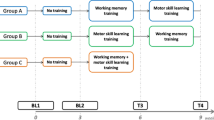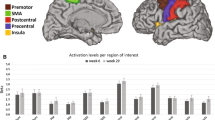Abstract
For prospective functional imaging studies of learning and for clinical studies of recovery or disease progression, it is important that the magnitude of brain activity does not exhibit a trend over repeated sessions in the absence of changes in task performance. This may confuse the interpretation of proposed mechanisms. The objective of this study was to use functional magnetic resonance imaging to determine if a linear trend in brain activity was present for simple and commonly used motor and cognitive tasks. Fourteen healthy individuals participated in three sessions on different days during which four scans each of a finger flexion task and a working memory task were performed in a block design. The general linear model was used to determine brain regions exhibiting activity differences between sessions conducted on different days, as well as between scans performed within the same session. Task-related brain activity decreased over sessions and scans in prefrontal and frontal cortices for both tasks. No increases, nor quadratic trends, were detected. Activity within premotor and ipsilateral primary somatosensory cortex decreased over scans for externally cued finger flexion and over sessions for self-paced finger flexion. Activity within parietal cortex and contralateral supplementary motor area decreased over sessions for all forms of finger flexion. These results suggest that motor planning and sensory regions, as well as frontal and parietal cortices, exhibit linear decreasing brain activity over repeated sessions in the absence of changes in task performance for even the simplest block design paradigms.


Similar content being viewed by others
References
Aguirre GK, Zarahn E, D’Esposito M (1998) The variability of human, BOLD hemodynamic responses. Neuroimage 8:360–369
Aron AR, Gluck MA, Poldrack RA (2006) Long-term test-retest reliability of functional MRI in a classification learning task. Neuroimage 29:1000–1006
Bapi RS, Miyapuram KP, Graydon FX, Doya K (2006) fMRI investigation of cortical and subcortical networks in the learning of abstract and effector-specific representations of motor sequences. Neuroimage 32:714–727
Calautti C, Brown J-C (2003) Functional neuroimaging studies of motor recovery after stroke in adults: a review. Stroke 34:1553–1566
Calautti C, Naccarato M, Jones PS et al (2007) The relationship between motor deficit and hemisphere activation balance after stroke: a 3T fMRI study. Neuroimage 34:322–331
Cannon TD, Glahn DC, Kim J, Van Erp TG, Karlsgodt K, Cohen MS, Nuechterlein KH, Bava S, Shirinyan D (2005) Dorsolateral prefrontal cortex activity during maintenance and manipulation of information in working memory in patients with schizophrenia. Arch Gen Psychiatry 62:1071–1080
Cohen MS, DuBois RM (1999) Stability, repeatability, and the expression of signal magnitude in functional magnetic resonance imaging. J Magn Reson Imag 10:33–40
Collins DL, Neelin P, Peters TM, Evans AC (1994) Automatic 3D intersubject registration of MR volumetric data in standardized Talairach space. J Comput Assist Tomogr 18:192–205
Cramer SC (2003) Functional magnetic resonance imaging in stroke recovery. Phys Med Rehabil Clin N Am 14(suppl 1):S47–S55
Curtis CE, D’Esposito M (2003) Persistent activity in the prefrontal cortex during working memory. Trends Cogn Sci 7:415–423
Dhamala M, Pagnoni G, Wiesenfeld K, Berns GS (2002) Measurements of brain activity complexity for varying mental loads. Phys Rev E Stat Nonlin Soft Matter Phys 65:041917
Douglas EA, Edwards JD, Goodyear BG (2006) Longitudinal functional MRI of motor and cognitive recovery following stroke: a review. Curr Med Imag Rev 2:105–116
Fernández G, Specht K, Weis S, Tendolkar I, Reuber M, Fell J, Klaver P, Ruhlmann J, Reul J, Elger CE (2003) Intrasubject reproducibility of presurgical language lateralization and mapping using fMRI. Neurology 60:969–975
Feydy A, Carlier R, Roby-Brami A, Bussel B, Cazalis F, Pierot L, Burnod Y, Maier MA (2002) Longitudinal study of motor recovery after stroke: recruitment and focusing of brain activation. Stroke 33:1610–1617
Forman SD, Cohen JD, Fitzgerald M, Eddy WF, Mintun MA, Noll DC (1995) Improved assessment of significant activation in functional magnetic resonance imaging (fMRI): use of a cluster-size threshold. Magn Reson Med 33:636–647
Friston KJ, Worsley KJ, Frackowiak RSJ, Mazziotta JC, Evans AC (1994) Assessing the significance of focal activations using their spatial extent. Hum Brain Mapp 1:214–220
Gonzalo D, Shallice T, Dolan R (2000) Time-dependent changes in learning audiovisual associations: a single-trial fMRI study. Neuroimage 11:243–255
Grafton ST, Hazeltine E, Ivry R (2002) Motor sequence learning with the nondominant left hand. A PET functional imaging study. Exp Brain Res 146:369–378
Graydon FX, Friston KJ, Thomas CG, Brooks VB, Menon RS (2005) Learning-related fMRI activation associated with a rotational visuo-motor transformation. Brain Res Cogn Brain Res 22:373–383
Hampson M, Driesen NR, Skudlarski P, Gore JC, Constable RT (2006) Brain connectivity related to working memory performance. J Neurosci 26:13338–13343
Hazeltine E, Grafton ST, Ivry R (1997) Attention and stimulus characteristics determine the locus of motor sequence encoding. A PET study. Brain 120:123–140
Jenkinson M, Bannister P, Brady M, Smith SM (2002) Improved optimisation for the robust and accurate linear registration and motion correction of brain images. Neuroimage 17:825–841
Kelly C, Foxe JJ, Garavan H (2006) Patterns of normal human brain plasticity after practice and their implications for neurorehabilitation. Arch Phys Med Rehabil 87:S20–S29
Lengenfelder J, Bryant D, Diamond BJ, Kalmar JH, Moore NB, DeLuca J (2006) Processing speed interacts with working memory efficiency in multiple sclerosis. Arch Clin Neuropsychol 21:229–238
Loubinoux I, Carel C, Alary F, Boulanouar K, Viallard G, Manelfe C, Rascol O, Celsis P, Chollet F (2001) Within-session and between-session reproducibility of cerebral sensorimotor activation: a test-retest effect evidenced with functional magnetic resonance imaging. J Cereb Blood Flow Metab 21:592–607
Macintosh BJ, Mraz R, McIlroy WE, Graham SJ (2007) Brain activity during a motor learning task: An fMRI and skin conductance study. Hum Brain Mapp 28:1359–1367
Meisenzahl EM, Scheuerecker J, Zipse M, Ufer S, Wiesmann M, Frodl T, Koutsouleris N, Zetzsche T, Schmitt G, Riedel M, Spellmann I, Dehning S, Linn J, Bruckmann H, Moller HJ (2006) Effects of treatment with the atypical neuroleptic quetiapine on working memory function: a functional MRI follow-up investigation. Eur Arch Psychiatry Clin Neurosci 256:522–531
Mezzapesa DM, Rocca MA, Rodegher M, Comi G, Filippi M (2007) Functional cortical changes of the sensorimotor network are associated with clinical recovery in multiple sclerosis. Hum Brain Mapp 29:562–573
Miller MB, Van Horn JD, Wolford GL, Handy TC, Valsangkar-Smyth M, Inati S, Grafton S, Gazzaniga MS (2002) Extensive individual differences in brain activations associated with episodic retrieval are reliable over time. J Cogn Neurosci 14:1200–1214
Newton AT, Morgan VL, Gore JC (2007) Task demand modulation of steady-state functional connectivity to primary motor cortex. Hum Brain Mapp 28:663–672
Noll DC, Genovese CR, Nystrom LE, Vazquez AL, Forman SD, Eddy WF, Cohen JD (1997) Estimating test-retest reliability in functional MR imaging. II: Application to motor and cognitive activation studies. Magn Reson Med 38:508–517
Osaka M, Komori M, Morishita M, Osaka N (2007) Neural bases of focusing attention in working memory: an fMRI study based on group differences. Cogn Affect Behav Neurosci 7:130–139
Rombouts SA, Barkhof F, Hoogenraad FG, Sprenger M, Scheltens P (1998) Within-subject reproducibility of visual activation patterns with functional magnetic resonance imaging using multislice echo planar imaging. Magn Reson Imag 16:105–113
Sadato N, Campbell G, Ibanez V, Deiber M, Hallett M (1996) Complexity affects regional cerebral blood flow change during sequential finger movements. J Neurosci 16:2691–2700
Specht K, Willmes K, Shah NJ, Jäncke L (2003) Assessment of reliability in functional imaging studies. J Magn Reson Imag 17:463–471
Sperling R, Greve D, Dale A, Killiany R, Holmes J, Rosas HD, Cocchiarella A, Firth P, Rosen B, Lake S, Lange N, Routledge C, Albert M (2002) Functional MRI detection of pharmacologically induced memory impairment Proc Natl Acad Sci USA 99:455–460
Sweet LH, Rao SM, Primeau M, Mayer AR, Cohen RA (2004) Functional magnetic resonance imaging of working memory among multiple sclerosis patients. J Neuroimaging 14:150–157
Tegeler C, Strother SC, Anderson JR, Kim SG (1999) Reproducibility of BOLD-based functional MRI obtained at 4 T. Hum Brain Mapp 7:267–283
Tombari D, Loubinoux I, Pariente J et al (2004) A longitudinal fMRI study: in recovering and then in clinically stable sub-cortical stroke patients. Neuroimage 23:827–839
Van Opstal F, Verguts T, Orban GA, Fias W (2008) A hippocampal-parietal network for learning an ordered sequence. Neuroimage 40:333–341
Walsh ND, Williams SC, Brammer MJ, Bullmore ET, Kim J, Suckling J, Mitterschiffthaler MT, Cleare AJ, Pich EM, Mehta MA, Fu CH (2007) A longitudinal functional magnetic resonance imaging study of verbal working memory in depression after antidepressant therapy. Biol Psychiatry 62:1236–1243
Ward NS, Brown MM, Thompson AJ, Frackowiak RS (2003) Neural correlates of motor recovery after stroke: a longitudinal fMRI study. Brain 126:2476–2496
Wei X, Yoo SS, Dickey CC, Zou KH, Guttmann CR, Panych LP (2004) Functional MRI of auditory verbal working memory: long-term reproducibility analysis. Neuroimage 21:1000–1008
Woolrich MW, Ripley BD, Brady JM, Smith SM (2001) Temporal autocorrelation in univariate linear modelling of fMRI data. Neuroimage 14:1370–1386
Worsley KJ, Evans AC, Marrett S, Neelin P (1992) A three-dimensional statistical analysis for CBF activation studies in human brain. J Cereb Blood Flow Metab 12:900–918
Acknowledgments
Thanks to Jodi Edwards for her assistance with data collection, and Louis Lauzon for pulse sequence development.
Author information
Authors and Affiliations
Corresponding author
Rights and permissions
About this article
Cite this article
Goodyear, B.G., Douglas, E.A. Decreasing task-related brain activity over repeated functional MRI scans and sessions with no change in performance: implications for serial investigations. Exp Brain Res 192, 231–239 (2009). https://doi.org/10.1007/s00221-008-1574-7
Received:
Accepted:
Published:
Issue Date:
DOI: https://doi.org/10.1007/s00221-008-1574-7




